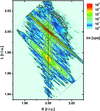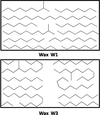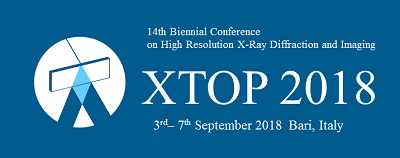issue contents
April 2017 issue

Cover illustration: Cover images courtesy of Peng & Nakashima [J. Appl. Cryst. (2017), 50, 602-611], Eicher et al. [J. Appl. Cryst. (2017), 50, 419-429], Brand et al. [J. Appl. Cryst. (2017), 50, 340-348] and Bikondoa [J. Appl. Cryst. (2017), 50, 357-368].
research papers
A new analysis technique for energy-resolved small-angle neutron scattering is proposed. The precipitate dimensions in steel determined from fitting the observed neutron attenuation spectra agree with those calculated from conventional fitting of the corresponding small-angle neutron scattering profiles.
A combination of time-of-flight neutron diffraction and synchrotron X-ray powder diffraction has been used to investigate the thermal expansion of a synthetic deuterated natrojarosite from 80 to 440 K under ambient-pressure conditions.
Both the expected and an additional orientation relationship between α-Zr and δ-hydride in blistered zirconium alloys are explored through the reconstruction of the parent α-Zr phase from electron backscatter diffraction maps of δ-hydride.
Open  access
access
 access
accessOn the use of two-time correlation functions for X-ray photon correlation spectroscopy data analysis
Two ways to analyse two-time correlation functions and the implications for the evaluation of the correlation times and functional shape of the correlations for equilibrium and non-equilibrium systems are discussed.
Open  access
access
 access
accessImaging with surface- and bulk-sensitive electron and X-ray diffraction based microscopic techniques enabled identification of the twin domain distribution of Bi2Te3 and Bi2Se3 thin films. Correlations between the surface topography and crystal orientation are established.
Open  access
access
 access
accessThis article details the use of birefringence imaging microscopy and high-resolution X-ray diffraction for determining the symmetries of the phases in PbHfO3 between room temperature and 870 K.
The unit-cell parameters of metastable orthorhombic SrIrO3 phases epitaxially stabilized on various substrates (DyScO3, GdScO3, NdScO3 and SrTiO3) are reported. The atomic coordinates of the SrIrO3 layers are determined by collecting X-ray diffraction curves of a large number of Bragg peaks. The present method, which is described in detail, utilizes not only the Bragg peak intensities but also the interference between waves diffracted by the substrate and the thin film.
Methods to implement nanostructured models for dynamical simulation of X-ray diffraction in non-periodic layered materials with large d spacing are described and applied to study the case of bismuth telluride epitaxial films grown on barium difluoride (111) substrates.
Examples of encoding for X-ray diffraction experiments are presented. The encoding was shown to recover critical information from the experiments.
Open  access
access
 access
accessLow- and high-resolution scattering length density models for the joint analysis of small-angle neutron and X-ray scattering experiments on asymmetric lipid vesicles are presented.
A basic theory is provided for the creation of orientation representations using three-dimensional visualizations. An extensive set of visualizations in both standard and anaglyph movie format is made available as supplementary material.
First-principles calculations are used to study the vibrational properties of MgF2 and BeF2. The calculated phonon densities of states are used to study the thermal neutron inelastic scattering cross sections as a function of neutron incident energy and temperature. Comparisons of neutron filter efficiencies and neutron transmissions through both materials are reported.
A method combining different multivariate techniques is applied to the analysis of large datasets of time-resolved X-ray powder diffraction patterns. The method is based on time-window statistical total correlation spectroscopy, which, together with evolving factor analysis and multivariate curve resolution, allows for the identification and the description of the time evolution of the crystalline as well as the amorphous fractions in the sample, in a semi-automated fashion.
Open  access
access
 access
accessThe certification of a new NIST standard reference material (SRM) for the calibration of small-angle X-ray scattering intensity is described, including the purpose, use and applicability of the SRM together with limitations and uncertainties in the intensity calibration provided.
The ability and technical requirements for a complex characterization of strained epitaxial layer systems using reflections in skew geometry are discussed for four examples of SiGe/Si(001) structures.
Open  access
access
 access
accessComprehensive characterization of the morphology of single-core and multi-core magnetic nanoparticle systems for future use as reference materials for magnetic properties was performed using a combination of small-angle X-ray scattering and static light scattering. The composition of the nanoparticle iron oxide cores was determined using XANES.
Rod-like particles with constant radius and variable length grow at the first stages of aggregation in the sol–gel processing of 1:1 molar mixtures of 3-glycidoxypropyltrimethoxysilane and tetraethoxysilane. Larger aggregates with higher dimensionality formed by rod-like subunits grow at more advanced degrees of aggregation.
A Rietveld–PONKCS (partial or no known crystal structure) technique is presented for the determination of the weight percentages of predominantly amorphous supplementary cementitious materials (SCMs) contained in Portland cement–SCM blends.
Open  access
access
 access
accessExtensive deformation of an iron alloy powder increases the static disorder contribution to the thermal factor, with an increase of ∼20% in the Debye–Waller coefficient observed by both X-ray diffraction and extended X-ray absorption fine structure. Molecular dynamics simulations shed light on the underlying mechanisms, confirming the major role played by the grain boundary.
Open  access
access
 access
accessScanning X-ray nanodiffraction with 100 nm spatial resolution has been applied to investigate the ferroelectric domain structure of K0.75Na0.25NbO3 epitaxial layers grown on a (110) TbScO3 substrate using metal–organic chemical vapour deposition. Two variants differing in domain wall alignment and vertical lattice parameters have been identified and independently analysed.
Open  access
access
 access
accessX-ray Bragg diffraction in sagittal geometry on a Y-cut langasite crystal (La3Ga5SiO14) modulated by Λ = 3 µm Rayleigh surface acoustic waves was studied at the BESSY II synchrotron radiation facility. The surface acoustic waves create a dynamical diffraction grating on the crystal surface, which can be used for space–time modulation of an X-ray beam.
Open  access
access
 access
accessIn this work the fluence efficiency of two coherent X-ray imaging techniques is studied by numerical experiments. The techniques surveyed are near-field holography and far-field diffraction imaging.
Open  access
access
 access
accessA set of complementary methods (high-resolution X-ray reflectivity, high-resolution X-ray diffraction, transmission electron microscopy and atomic force microscopy) were used to study structural changes in the surface Si layer after high-dose low-energy (2 keV) He+ plasma-immersion ion implantation and subsequent thermal annealing. This combination is proved to be a powerful tool for complete structural diagnostics of nanoscale He+ ion implanted Si layers, especially in the ultra-low-energy implantation regime.
Open  access
access
 access
accessX-ray diffraction imaging in both monochromatic and white beam section mode has been used to measure quantitatively the displacement and warpage stress in encapsulated silicon devices.
Open  access
access
 access
accessPolar GaN layers containing domains with inverse polarities are studied by means of high-resolution X-ray diffraction and transmission electron microscopy. It is shown how the presence of inversion domain boundaries can be recognized directly from reciprocal-space maps measured by X-ray diffraction.
Open  access
access
 access
accessBragg diffraction imaging techniques are described, and their capabilities for studying the quality of diamond substrates and overgrown layers, and the surface damage caused by mechanical polishing, are illustrated by examples.
Open  access
access
 access
accessAn X-ray reflectometer, using a laboratory X-ray source, that can measure the specular X-ray reflectivity curve with a time resolution of 10 s or less was developed. Low reflectivities can be measured accurately because the background can be subtracted from the signal.
Configuration interaction cluster calculations have been performed to investigate the LaTiO3 Ti L23-edge absorption spectrum, providing a comprehensive understanding of the multiplet structures. Detailed temperature- and polarization-dependent simulations reveal the low-temperature orbital state, the orbital–lattice interactions and the orbital polarizations in the compound.
The analysis of peak asymmetry induced by a size-dependent lattice constant is presented. A method is developed for recovering this size dependency, together with the column length distribution for metal nanocrystals with negligible microstrain broadening.
The mean value of the scattering density fluctuation must behave asymptotically as V−1/2 for the scattering intensity limit at the reciprocal-space origin to exist.
The influence of specimen preparation and crystal perfection on the measurement of structure factors and bonding by quantitative convergent-beam electron diffraction is assessed in detail. Whilst CeB6 is the subject of this study, the findings and methods apply to all hard brittle crystalline materials.
This article presents scanning small-angle X-ray scattering (SAXS) experiments performed on the actomyosin assemblies in freeze-dried cardiac muscle cells by scanning the sample through a sub-micrometre focused beam. The scanning SAXS experiments were advantageously combined with full-field holographic imaging to complement the X-ray diffraction with real-space imaging.
Open  access
access
 access
accessA model is presented for the errors in small-angle X-ray scattering profiles that takes into account the physics of the measurement process. The model agrees quantitatively with the variations observed in experimental measurements and provides a straightforward prescription to add realistic errors to simulated scattering profiles.
Open  access
access
 access
accessThe equilibrium relative humidity values for a number of the most commonly used precipitants in biological macromolecule crystallization have been measured using a new humidity control device. A simple argument in statistical mechanics demonstrates that the equilibrium vapour pressure of a solvent is proportional to its mole fraction in an ideal solution (Raoult's law). The same argument can be extended to the case where the solvent and solute molecules are of different sizes.
short communications
A petroleum wax has been extracted from an Indian crude oil and crystallized into two fractions, depending on its solubility in methyl isobutyl ketone–toluene at 298 and 313 K. The crystalline nature of the fractionated waxes has been determined by X-ray diffraction.
Differences in f′ and f′′, absorption and wavelength dispersion are discussed with respect to correction of diffraction data for λ/2 contamination.
computer programs
A Windows console program, Ind_X, for indexing single-crystal diffraction patterns is presented, and the implemented indexing method is briefly described.
A powder indexing software, CONOGRAPH, as an integrated system is reported.
laboratory notes
Open  access
access
 access
accessThe application of IR spectroscopy to the analysis of D2O/H2O back-exchange in samples used for neutron crystallography is described.
addenda and errata
Free 

Erroneous equations in the paper by Toraya [J. Appl. Cryst. (2016), 49, 1508–1516] are corrected.
crystallographers
Free 

international union of crystallography
Free 

book reviews
Free 



 journal menu
journal menu
































































